
| Farming snails 1: Learning about snails; Building a pen; Food and shelter plants source ref: fb33fe.htm |
| Learning about snails |
Learning about snails
11. To farm snails is not hard; however, it is quite different from keeping chickens or ducks or from growing crops such as maize, rice, cassava or groundnuts.
12. Since farming snails is so different from other kinds of farming, you will have to learn a lot of new things.
13. One way to learn about snails so that you will be able to farm them is to watch the wild snails that live near you.

Watch the wild snails
14. Try to see how they live, how they move and where they go, what plants they like best and what they eat.
15. You can learn many things by watching wild snails that will help you later if you decide to start a snail farm.

Wild snail
16. Another way to learn about snails is to ask an older farmer who knows a lot about your area. If there are people near you who gather snails to sell to others, they may be able to help you.
17. In the next part of this booklet, you will begin to learn some things that you need to know to farm snails.
What kind of snails can you farm?
18. The kind of snails that you can farm are snails that live on land, and there are many kinds of land snails that are good to eat.
19. However, some kinds of land snails are not good to eat and they may even make you very, very sick.
20. So, you must be very careful when you choose snails to farm. If you are not sure that a snail is good to eat, do not use it.
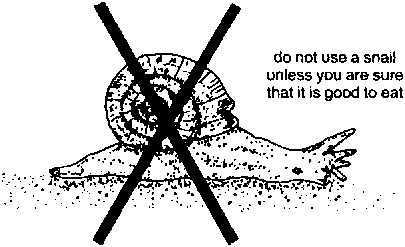
Do not use snail unless you are sure it is good to eat
21. Now look at the drawings on pages 8 to 11 and you will see four kinds of good snails that live in different places.
22. You may be able to find one of these kinds of snails where you live. Notice that two of them are small and two of them are large.
23. The smaller kinds of snails, shown on pages 8 and 9, can often be found in places where part of the year is warm and part of the year is cold.
24. The larger kinds of snails, shown on pages 10 and 11, can often be found in places where it is warm all year round.

Helix pomatia
This kind of small snail
1 can be found in places where part of the year is warm and part of the year is cold
2 weighs from 15 to 25 grams and measures from 40 to 50 millimetres
3 has a strong shell which is pale brown and off- white
4 grows to full size in two to three years if it is well fed
5 lays from 30 to 50 eggs each growing season

Helix Pomatia - 30 to 50 small eggs

Helix aspersa
This kind of small snail
1 can often be found in places where part of the year is warm and part of the year is cold
2 weighs from 4 to 20 grams and measures from 30 to 45 millimetres
3 has a weak shell with broken stripes which are light brown to black
4 grows to full size in one year if it is well fed
5 lays from 40 to 170 eggs one to three times each growing season

Helix aspersa - 40 to 170 small eggs

Achatina achatina
This kind of large snail
1 can often be found in places where it is warm all year round
2 weighs from 150 to 200 grams or more and measures from 90 to 130 millimetres
3 has a very strong brown shell
4 grows to full size in two years if it is well fed
5 lays from 100 to 300 eggs one to two times each growing season

Achatina achatina - 100 to 300 small eggs
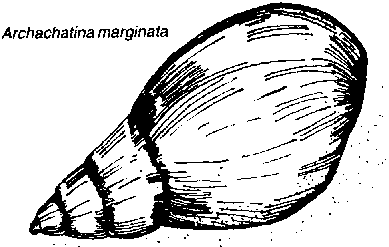
Archchatina marginata
This kind of large snail
1 can often be found in places where it is warm all year round
2 weighs from 150 to 200 grams or more and measures from 90 to 130 millimetres
3 has a very strong brown shell
4 grows to full size in two years if it is well fed
5 lays from five to ten eggs four to eight times each growing season
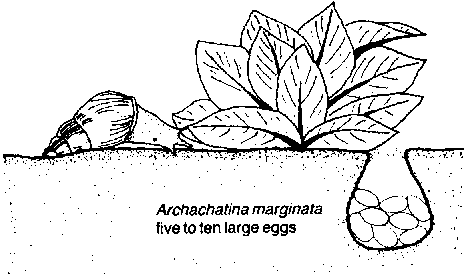
Archchatina marginata - five to ten large eggs
25. If you cannot get one of these snails, you may be able to get others very much like them where you live.
26. There are many other kinds of good snails. There may even be several kinds of good snails that are eaten where you live.
27. If snails are eaten where you live, you can farm one of these. Then you will be sure that it is good to eat.
Where can you get snails?
28. When you are ready to get snails, perhaps you can get them by gathering wild snails that live near you.

Gathering wild snails
29. Perhaps you can buy them from people who gather wild snails to sell to others.

Buying from one who gathers wild snails
30. You may even be able to buy them from another snail farmer.
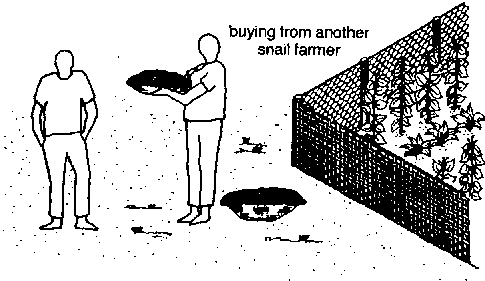
Buying from another snail farmer
Note
Never term snails that you buy at the market. Snails at the market may have been washed, kept too cold or hurt and they may die soon.
Where can you farm snails?
31. A good place for a snail farm is one where there already are snails. If there already are snails, you will know that the soil and the water in the soil are right for snails to live and grow.
32. However, if there are no snails near where you live it does not mean that you cannot raise snails there.
33. If you have the right kind of soil with the right amount of water, you can bring good snails from another place to start your snail farm.
The soil and the water in the soil
34. Soil is important for snails. Part of the time they live on the soil and part of the time they live in the soil, and to live well, snails need good soil.
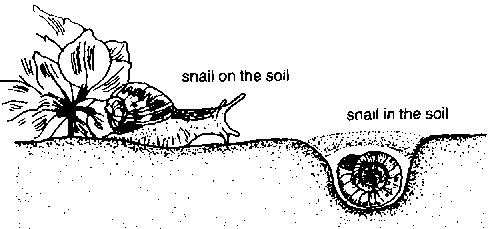
Snail on the soil; Snail in the soil
35. When snails are not on the soil or in the soil, they are on plants which grow in the soil. So, the soil must also be good for the kinds of plants that snails need.
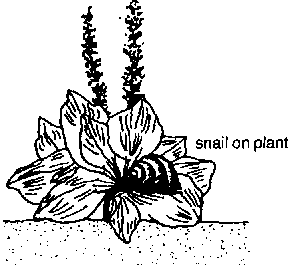
Snail on plant
36. When snails are in the soil, they are resting or laying their eggs. If the soil has the right amount of water, snails will live well, the eggs they lay will hatch well and the baby snails will come out of the soil easily.
37. Snails cannot live in hard soil such as heavy clay soils. When heavy clay soil is too dry, snails cannot dig into it to rest and lay their eggs. When heavy clay is too wet, snails and the eggs they lay may die.
38. Snails cannot live in loose soil such as soils that have a lot of sand. Sandy soils do not hold enough water for snail eggs to hatch.
39. The drawings on the next page show how a snail digs a hole, lays its eggs, closes the hole and how the baby snails come out when they have hatched.
40. Snails need calcium from the soil to make their shells. All snails grow better and have stronger shells when there is a lot of calcium in the soil.
41. So, if you are going to farm snails, you must have a good medium soil that has neither too much clay nor too much sand. It must also have enough calcium and the right amount of water for your snails to live and grow.
Note
If you have a garden, you can easily tell if your soll is good for snails. If your green leafy vegetables grow well, snails will also grow well in the same kind of soil
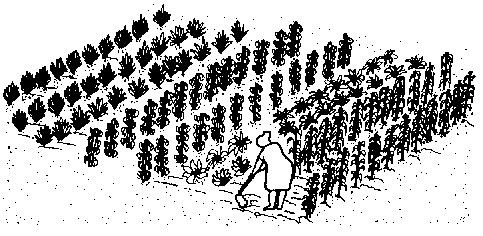
Snails will grow well in a garden
1 snail digging a hole

1 snail digging a hole
2 laying the eggs and closing the hole
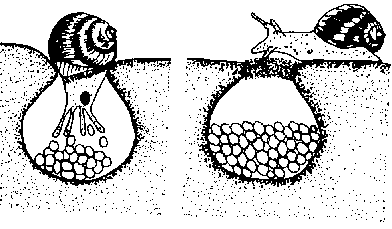
Snail laying eggs
3 baby snails hatching and coming out of the hole

Baby snails hatching and coming out of the hole
Plants for food and plants for shelter
42. Snails need plants for both food and sheller. Most kinds of snails use several kinds for food and several other kinds for shelter.
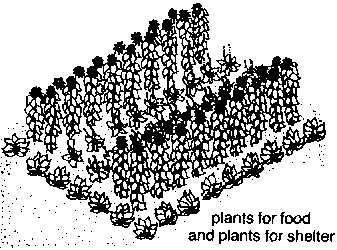
Plants for food and plants for shelter
43. They may also use different plants for food and shelter at different times of the year. Sometimes during the growing season snails eat and find shelter on the same plants.
44. Snails usually hide on shelter plants during the day when it is dry and move to food plants to eat at night or early in the morning when they are wet with dew. However, sometimes snails do eat during the day after it has rained.
45. If you live in a place which has a season when plants do not grow, snails will dig into the soil to rest and they do not eat then.
46. During the growing season snails will eat a lot and grow very fast if they have food plants that they like.
47. So, before you begin you will have to find out exactly what plants they like to eat. To do this you will have to watch snails at night when they eat.

See what snails eat at night
48. You can tell that snails are eating when you see their heads moving as they scrape food into their mouths. You can also tell when a snail has been eating by the holes it makes in the leaves.
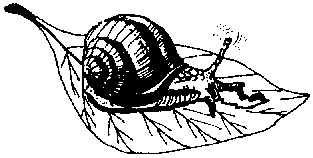
Snail on leaf
49. You will also have to find out what plants they like for shelter. To do this you will have to watch snails during the day when they rest.

See where snails rest during the day
50. It is often difficult to find snails on shelter plants because they are hiding. So, you will have to look very carefully.
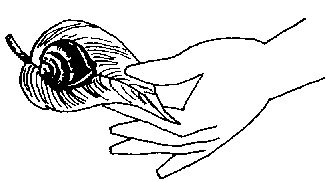
Snails are hiding on shelter plants
51. In addition to the food plants, there are many other kinds of foods that you can put into a pen for your snails to eat. You will learn about these foods and when you should use them in the next booklet in this series.
Dew and rain
52. Dew at night in the growing season helps the plants to grow and makes the leaves and the ground wet so that snails can move about.
53. Rain in the growing season also helps the plants to grow and it cleans the plants of dust and the dirt that snails leave when they move about. The dirt that snails leave may make them sick.
54. So, it is very important that the food and shelter plants are wet and clean.
55. When the leaves are wet, snails move easily, eat more and grow well. When the leaves are dry, snails move very little, or not at all, and they grow poorly.
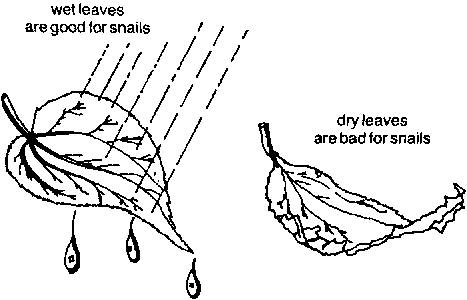
Wet leaves are good for snails
56. When it rains and the plants are clean, the snails will be healthy. When it does not rain and the plants are dirty, the snails may get sick.
57. Dew and rain also keep the ground moist so that the snails can move easily and dig into it to rest and to lay their eggs.
58. In the next booklet, you will be told how to wet the leaves of plants and moisten the ground when it is too dry.
Land that is wet
59. Land that is very wet, low land that does not drain well or land that floods in the rainy season is not good for snail farming.

Low, wet land is bad for snails
Wind
60. Wind during the growing season is bad because it dries the dew and dries out the snails.

Wind is bad for snails
61. If you decide to farm snails, try to keep them in a place that is protected from the wind.
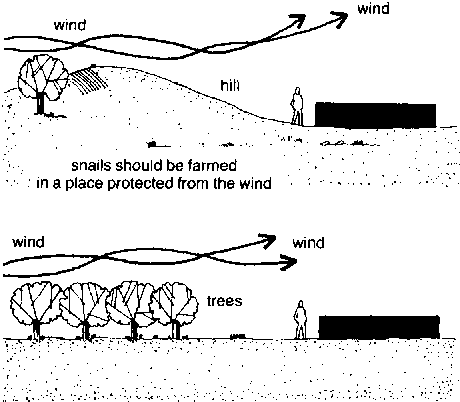
Snails should be farmed in a place protected from the wind
Where do you keep snails when you farm them?
62. If you decide to farm snails you must keep them in a pen. Snails kept in a well- built pen will not get away easily and you can watch them and take care of them well.
63. After the first year you will need at least two pens. If you decide to farm more snails you may want even more pens. You will learn how to use two or more pens in the next booklet.

Two pens the second year
64. In each pen you can give your snails the right kinds of plants for them to eat and to use as shelter.
65. In each pen you can put the food and shelter plants near each other so that the snails can move easily from one to the other.
66. Each pen you build must also keep the snails safe from their enemies. Snails have many enemies. You must be careful to protect them from
• mice and rats
• shrews and moles
• walking insects that live on the ground such as ants and beetles
• slugs and other snails that eat snail meat
• birds that eat snails
• frogs and toads
• thieves

Protect them from…
67. A snail pen can be small or large depending on how many snails you want to raise. However, when you first begin, start with a small pen. You will need fewer materials. It will be easier to take care of.
68. In addition, with a small pen you will need fewer snails to begin. When you know more about raising snails, you can build a bigger pen and get more snails to raise.
69. A good size for a pen is 5 x 5 metres. Later in this booklet you will learn how to build a small pen of this size.
How many snails will you need when you first begin?
70. If you are using small snails like those you have seen on pages 8 and 9 in this booklet, you will need more snails to begin.
71. If you are using large snails like those you have seen on pages 10 and 11 in this booklet, you will need fewer snails to begin.
72. With a pen of 5 x 5 metres (25 square metres) you will need
• 150 snails if you use the small kind (6 for each square metre)
• 25 snails if you use the large kind (1 for each square metre).

150 small snails; 25 large snails
How much snail meat can you expect to get?
73. The amount of snail meat that you will get from small snails will be about the same as what you would get from large snails. This is because you will use many more small snails than large snails and the meat will be about equal.
74. With one 5 x 5 metre pen you will get 12 to 13 kilograms of snail meat each year and with two 5 x 5 metre pens you will get 24 to 26 kilograms each year.
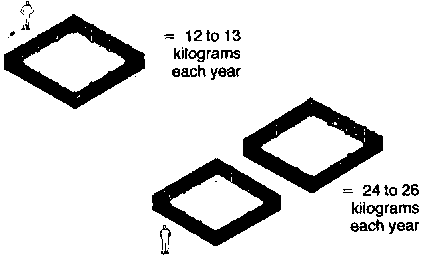
12 to 13 kilograms each year; 24 to 26 kilograms each year
Now you must decide
75. In the first part of this booklet you have learned many things about snails and farming snails. You have learned
• why it is good to farm snails
• what you need to farm snails
• what kinds of snails you can farm
• how to find plants near you that are good for food and shelter
• what kind of soil and how much water in the soil snails need
• where to keep snails and how many you need to start
76. You may also have been able to learn a lot about snails by watching the wild snails near where you live.
77. An old farmer may have told you what he knows about snails. Someone who gathers snails to sell to others or another snail farmer may have helped you to learn.
78. So, now that you know a lot about snails it is time to decide if you would like to start your own snail farm.
79. If you would like to begin you will learn exactly what to do in the rest of this booklet and in the next booklet.
